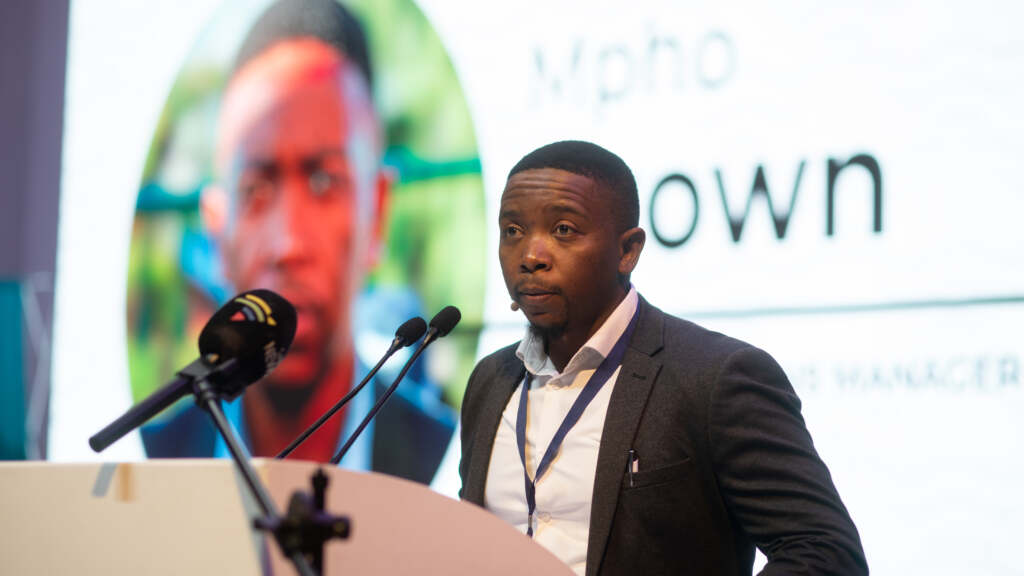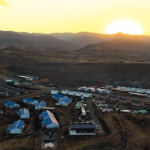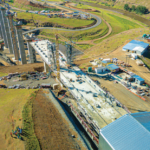Bereng Mpaki
In an exclusive interview with Newsday, Mpho Brown, the Public Relations Manager for the Lesotho Highlands Development Authority (LHDA), sheds light on the ambitious new strategic goal aimed at improving the livelihoods of those affected by the project. This goal, encapsulated in LHDA’s new 10-year strategy, reflects the aspirations of the governments of Lesotho and South Africa as outlined in the Lesotho Highlands Water Project (LHWP) Treaty. Brown discusses how this initiative goes beyond merely restoring what has been lost.
Newsday: What does improving the livelihoods goal entail? What motivated this goal?
Mpho Brown (MB): Our Strategic Goal number three, in the new 10-year strategy is the essence of what the Lesotho Highlands Water Project (LHWP) is about. It is the essence that was captured in the aspirations of the governments of Lesotho and South Africa when they signed the LHWP Treaty. In the Treaty Preamble, the parties express a desire to “enhance the conditions of the lives of the people of the Kingdom of Lesotho and the Republic of South Africa.” This goal is the LHDA reconnecting and recommitting to that aspiration in a big way. The goal entails programmes that are aimed at not just RESTORING what the project has affected and taken away, but also specific initiatives that focus on IMPROVING the livelihoods of those affected. In the past, we had focused on livelihood restoration, through our compensation and resettlement programmes that aimed to replace and restore what the project had taken from affected communities. Our goal and understanding now is that restoring is the starting point, the bare minimum, our goal and obligation is to improve. The goal, therefore, is anchored on four things: Compensation, Livelihoods Diversification, Skills Development, and Infrastructure Development (roads, water and sanitation, and electricity). We have a comprehensive list of programmes outlined under each of those to ensure that we meet the goal, and these are all captured in detail in the LHDA Livelihoods Restoration Masterplan, which is our black book for how we are going to improve and transform the lives of project-affected communities and Basotho at large, over the life of this project.
The goal was motivated by our realisation that, whilst there have been significant benefits to Lesotho and Basotho from the LHWP, there was a need, room, and indeed an obligation to do more. There are certain powers and allowances contained in the Treaty for the development of Basotho that we had not fully captured and implemented. We realised that while we had done an exceptional job with the engineering and infrastructure development of the project, Basotho were still unhappy, and rightfully so, about some things that we should have done better.
Newsday: What key deliverables can be expected under the goal?
MB: One of our highest priorities and deliverables under this goal is to make sure that our basic obligation of compensation payments is covered in full. This includes payment of legacy compensation payments from Phase I. As I mentioned, this is the baseline from which our livelihoods diversification and skills development efforts must stem. So the first deliverable is to ensure 100 percent compensation due, paid by 2027.
Secondly, this goal says that we commit to helping project-affected communities to diversify their livelihoods and income streams, to find new ways to make a living using the opportunity created by the project. We aim to have at least 60 percent of project-affected households with diversified income streams by 2034. As things stand, we already have programs running to achieve exactly that – the Trade Skills Development, Testing, and Accreditation Program that we have under Phase II, not only equips community members with the skills for construction and built environment that are in demand within the project, but it also certifies and accredits them in partnership with the Ministry of Education, and through that they can receive gainful employment within the project and across Southern Africa in all SADC countries. We also have a Community Tourism training program in partnership with LTDC that trains, equips, and prepares community members with the skills to start up tourism sector businesses that will create value from the large tourist traffic that the LHWP attracts during and after the completion of Phase II. Over and above this, programmes are in the pipeline for Enterprise Development, Commercial Income Generation Facilities, and production projects, as well as solar energy generation within project communities to make power available to communities at very affordable rates.
Some of the key deliverables that we are going to measure our success on under this goal, on top of the ones mentioned already, are: Over 100km of access roads will be constructed around the Polihali Reservoir by 2028. 85km of feeder roads at Mohale, and 135km at Katse, will be rehabilitated by 2030. 100 percent of the communities in the project catchment will have access to water and sanitation by 2028, and 100 percent of resettled communities and households will have access to electricity by 2028. Also, four health facilities will be constructed by the project by 2028.
Newsday: The LWHP is historically renowned for its outstanding engineering feats, but is less pronounced on its social impact. What challenges does the LHDA encounter in its endeavors to adequately transform the lives of the stakeholders as dictated in the LHWP treaty?
MB: As mentioned earlier, the obligation and the mandate to make a tangible and pronounced social impact is contained right in the LHWP Treaty Preamble. And it is important to note that in its 37-year history, the LHWP has created tremendous value for Lesotho and Basotho. In Phase I, over 16,000 jobs were generated for the economy, with over M1 billion spent in wages to Basotho, M1.2 billion spent locally on goods and services, and over M500 million paid to Basotho contractors and consultants. Phase II will return similar and bigger numbers for the economy and social transformation of Lesotho. Currently, every month the government of Lesotho receives close to M300 million in revenue from the LHWP royalties; to date, M16,2 billion has been collected in Royalties revenue from the LHWP. By the end of 2010, there had already been over 2000km of roads and road networks built and upgraded, and access to health services, schools, and centers of economic activity improved. Over 2,200 households have been provided access to portable water supply under the project’s water and sanitation projects, and 4,490 households provided electricity under the project’s rural electrification project. And these are just a few of the positive socio-economic benefits that accrue from the LHDA and the LHWP.
That said, there are challenges encountered in meeting the desired levels of impact and social transformation that we desire, and that Basotho deserve. I will mention just a few that we find to be very important. One of the main ones, which I have already alluded to, is that, under Phase I, we were so intent on delivering the world-class infrastructure and engineering demanded by this project that, socio-economic beneficiation fell secondary to the technical work. The results of that neglect manifested themselves after Phase I, and we have spent the past 12 to 13 years since the signing of the Phase II agreement, working to make sure that we correct that. That is a challenge that falls squarely on us, and we have taken steps to correct it. Phase II is being led and implemented with Socio-Economic beneficiation for both Lesotho and South Africa as the centerpiece and the goal, and engineering is the means to an end. This new strategy and its goals are a further testament to that. A second challenge worth mentioning is that of project financing. Needless to say, the LHWP is a huge financial undertaking by both the government of Lesotho and the South African government. It does happen that some crucial aspects of project work, those that are tied directly to community beneficiation projects, do not receive adequate financing – either in amount, or in the time it is needed, and this can lead to delayed implementation, and thus, deferred socio-economic impact and benefits for Basotho. It is important to note here that the stringent and thorough governance structure of the LHWP, means that full transparency and equity are achieved in project matters, it also has the unintended consequence of delaying key decisions regarding financing of some of the beneficiation programs. In recent years, we have experienced a painful spell of short-funding from our government, which has in turn impacted the delivery and/or completion of some of our work in non-negligible ways. The third challenge to achieving the levels of beneficiation that we at the LHDA and as the LHWP desire; is simply a function of some unwarranted expectations on the side of the communities we serve. With the project’s thorough and strict governance, processes, and contractual obligations that we hold ourselves and our contractors to – in many cases – the LHDA is demanded to do and achieve requests that are, by any measure, beyond our ability, scope or mandate, and despite our best efforts with engagement, participation, and communication, those messages are not heard, which results in unhappy communities that can disrupt planned work, as they have done many times in recent times. This is a challenge for beneficiation simply because the longer it takes for the work and the projects to complete, the longer communities have to wait to realise the benefits of the project in their locale.
All in all, these challenges and others, and some of the key triggers of this new 10-year strategy, and there is a goal in the strategy for many if not all of them.
Newsday: There are indications that some stakeholders are still yet to receive their compensation monies for their acquired assets under the first phase of LHWP implementation, which was completed around 2004. How will such issues be addressed to speed up the compensation of affected communities to ensure the project is not a source of their poverty?
MB: Legacy compensation issues that have dragged on for close to 20 years are a source of extreme agony, and worry for us. Whilst for many of them there are clear reasons why they have taken the time they did – our only focus now is to ensure 100 percent payment of all those past due compensation payments, as indicated earlier. To tackle this, there was the implementation of new compensation payment and management processes and technology solutions, as well as improvements on the complaints management process and platforms, which allow us to keep track of legacy issues and monitor them until resolution. Further, the LHDA, and its principals in the Board of Directors and the Lesotho Highlands Water Commission, have revisited key documents such as the delegation of authority which should facilitate quicker turnaround times on key activities such as compensation payments. Lastly, going forward, the Phase II agreement, Phase II compensation policy, and related procedures for Resettlement Panning and Livelihoods Restoration; all have taken into account comprehensive learnings from our shortfalls under Phase I, and for each failure we have improved, intentionally and robust way to ensure success going forward.
Newsday: Certain quarters of the society have called for the revision of the LHWP II compensation policy, which they feel is not adequately aligned with the interests of the affected communities. What informs the review of the LHWP policies, and how often is this done?
MB: It is difficult to hear that, and sometimes challenging to understand, and one wonders whether perhaps the view is based on a thorough reading of the policy itself, or if it’s a stance influenced by experience with the Phase I compensation challenges we discussed. Perhaps we can have a broader conversation about the Phase II compensation policy, its background, principles, procedures, and the legal framework around it in the future. I believe that it is one of the more well-thought-out, consulted documents that we have, and it is biased very strongly for the benefit of project-affected communities.
But to answer the question, the Phase II compensation policy can be reviewed as and when it is required. It is meant to address compensation processes for the period of implementation of Phase II. What can trigger a review of the policy are things such as changes in the legislation and laws of Lesotho. And when there are such changes, as has been already under Phase II, amendments are proposed to the policy. Any amendments to the policy cannot be made without the full involvement of the affected communities through their various structures and representation, and the involvement of the relevant authorities and stakeholders of the project. When amendments are proposed, consultations and participation completed from all the above, they must be approved by the LHDA Board, and the Lesotho Highlands Water Commission (LHWC). This is important to state because the LHWC is the governance body where both the government of Lesotho and the government of South Africa are represented, and both must agree unanimously on the proposed amendments.
Newsday: In the past, many LHWP stakeholders have complained about a lack of financial support on how to manage their bulky compensation funds leading to reckless spending and their subsequent poverty. How does the goal intend to address this?
MB: There are already ongoing programs under this goal that are targeted at addressing this very same issue. The LHDA’s Financial Literacy and Wellness program is a strong multi-partner effort to ensure that beneficiaries of compensation payments are prepared adequately with the knowledge that they need to make sound financial decisions with their monies.
We implement the program with all financial services providers from the Central Bank of Lesotho to commercial banks, insurance companies, investment companies, mobile money operators, microfinance institutions, and the list goes on. Periodically, at regular intervals as much as feasible, the LHDA and these partners visit project-affected communities and set up camp over a few days and weeks, providing training, education, and onboarding, across a spectrum of financial solutions and options.
That is just one part of the equation. Another part of the equation is what you will see under both this Goal and Goal 4 of this new strategy, where we are committing to ensuring that there are robust, enterprise development initiatives such as commercial operations and companies where the communities and community members can co-invest with the LHDA to build operations that create value and revenue for the affected communities. This partnership potential not only means that communities will have much better prospects for investing their funds with the operations that are backed by LHDA and other credible and already established entities, but this will also result in investments that are much more sustainable and create lasting impact in the communities.
Summary
- In the Treaty Preamble, the parties express a desire to “enhance the conditions of the lives of the people of the Kingdom of Lesotho and the Republic of South Africa.
- We have a comprehensive list of programmes outlined under each of those to ensure that we meet the goal, and these are all captured in detail in the LHDA Livelihoods Restoration Masterplan, which is our black book for how we are going to improve and transform the lives of project-affected communities and Basotho at large, over the life of this project.
- As things stand, we already have programs running to achieve exactly that – the Trade Skills Development, Testing, and Accreditation Program that we have under Phase II, not only equips community members with the skills for construction and built environment that are in demand within the project, but it also certifies and accredits them in partnership with the Ministry of Education, and through that they can receive gainful employment within the project and across Southern Africa in all SADC countries.

Your Trusted Source for News and Insights in Lesotho!
At Newsday Media, we are passionate about delivering accurate, timely, and engaging news and multimedia content to our diverse audience. Founded with the vision of revolutionizing the media landscape in Lesotho, we have grown into a leading hybrid media company that blends traditional journalism with innovative digital platforms.








